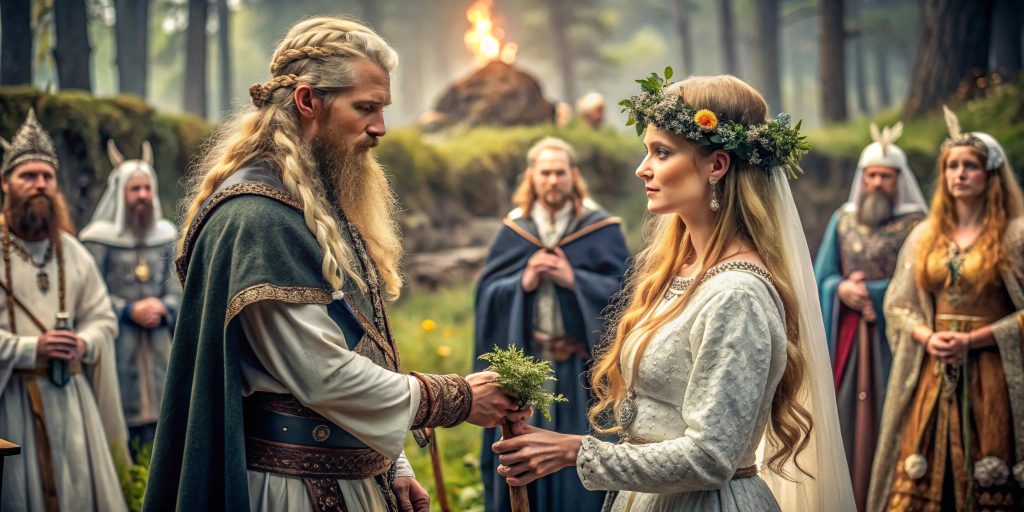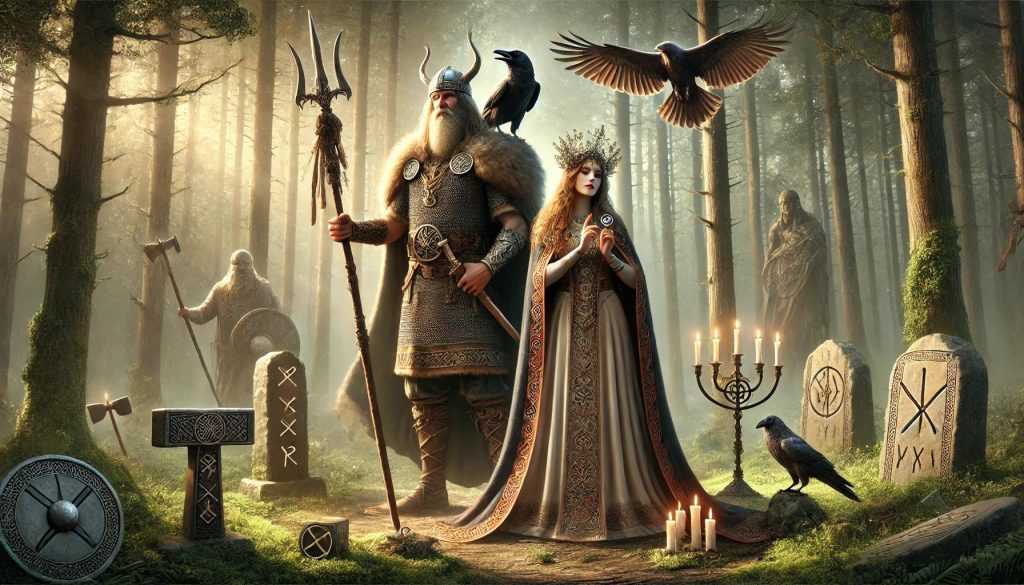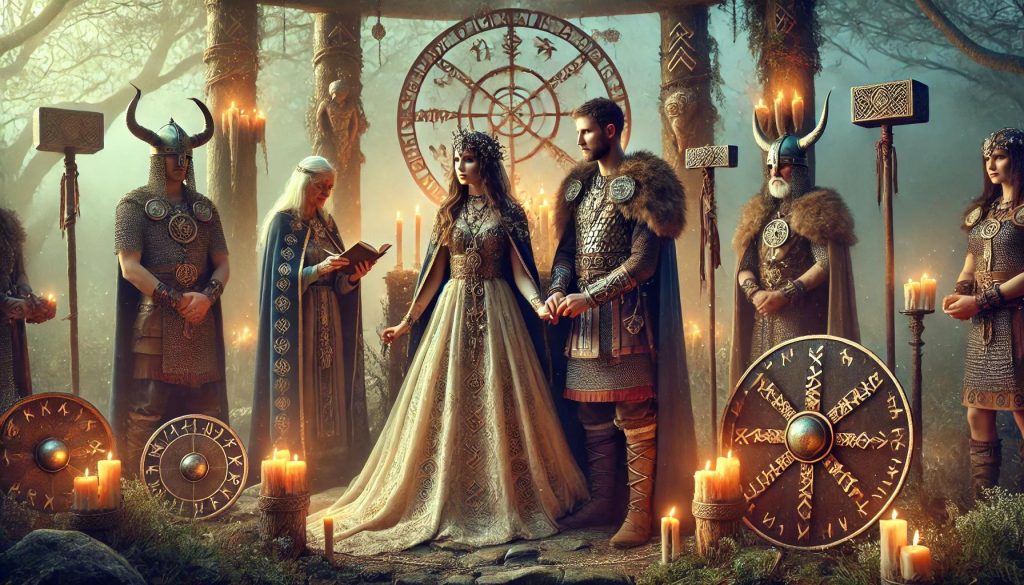Daily Life in the Viking Age, Frigg, Norse Goddesses, Norse Gods, Norse Mythology, Odin, Vikings
Norse Pagan Wedding Traditions: From Blóts to Blessings in Viking Marriages
Norse pagan wedding traditions are filled with history and meaning. They are deeply rooted in Viking culture’s values and beliefs. These weddings were not just ceremonies but deep rituals that showed the couple’s bond with the divine, akin to the sacred practices of the Vikings.
These rituals included customs like Blóts, where offerings were made to gods, ensuring blessings for the couple’s union.
Exploring these ancient practices, we’ll examine their cultural background and see how these ceremonies have changed. Today, many couples draw inspiration from these traditions and incorporate them into their modern weddings.
Looking back, we can understand how Norse pagan wedding traditions still shape today’s celebrations. They remain relevant in our modern world.
Introduction to Norse Pagan Weddings
Norse pagan weddings combine deep cultural traditions with historical importance. They show how marriage is key to linking people, families, and communities. These ceremonies celebrate loyalty, kinship, and honor to deities, echoing the values upheld by the Vikings.
These weddings often celebrate nature with rituals for blessings and wealth. Family is central, with everyone there to support the couple. This shows the community spirit tied to Norse myths and gods.
Couples start their life together with customs that show their bond, echoing the wedding rituals of ancient Norse culture. These customs connect them to their heritage and ancestors. By exploring Norse pagan weddings, we learn about the lasting cultural values and identity.
The Significance of Blóts in Viking Marriages
The blót is key in Norse pagan wedding ceremonies. It’s a ritual that links the couple to the divine. This offering to the gods creates a sacred bond, bringing blessings to the couple, as told in the sagas.
Couples perform these rituals to honor their ancestors and seek the gods’ favor, connecting the past to the present.
What is a Blót?
A blót is a traditional Norse ceremony. It involves offerings to gods, spirits, or ancestors. It’s a moment for the couple to show gratitude and devotion.
They seek blessings from Thor for their future together. A priest or priestess leads the ritual, often at a sacred site. This act makes the wedding more spiritual, strengthening the couple’s bond and community ties.
Ritual Offerings and Their Importance
Ritual offerings can be food, drink, or symbols of fertility and prosperity. They are vital in strengthening the couple’s bond with the divine and bringing the community together.
Friends and family gather to celebrate. Blóts in Norse pagan weddings highlight ancient customs. They show the importance of shared rituals. Couples seek blessings and honor their heritage, keeping traditions alive.
Norse Pagan Wedding Traditions: Sacred Rituals and Symbolism
Norse wedding traditions mix sacred rituals with deep symbolism. They emphasize the values of unity, love, and respect. A key ritual is the exchange of gifts, which shows commitment and support.

Gifts mean relationships grow strong with shared resources and teamwork. This act shows the power of working together.
Lighting fires is another big part of Norse weddings. Fire symbolizes warmth and passion. It also shows the bond between the couple, reminiscent of the strong connections seen among the Vikings.
By lighting fires, people ask for the gods’ blessings. They wish for a happy and united future. This act brings everyone together, creating a spiritual bond.
Communal prayers are also key. Friends and family pray together, showing support for the couple. These prayers strengthen bonds and show the value of community.
These rituals show what Norse culture values. Each one tells a story of love, loyalty, and union. They shape how we celebrate weddings today.
Handfasting: Tying the Knot in Norse Culture
Handfasting is a deep tradition in Norse marriage rituals. It shows the bond between partners. The couple’s hands are physically bound, showing their commitment.
This tradition is still important today. It shows the lasting value of handfasting in our celebrations.
The Meaning Behind Handfasting
In Norse culture, handfasting is more than just a legal bond. It’s about joining two people’s lives, hearts, and souls. This ceremony highlights their spiritual connection to the old Norse beliefs.
During the Norse pagan wedding ceremony, the couple makes personal vows. This adds depth and meaning to the act of tying the knot, reflecting the significance of Norse wedding rituals.
How Handfasting is Performed
A traditional handfasting ceremony has several parts:
- The couple stands before family and friends, showing their commitment.
- A special cord or ribbon is chosen to bind their hands in a bridal ceremony. It represents their journey together.
- Vows are exchanged, promising love, support, and loyalty.
- The hands are bound together, marking the start of their shared life.
This tradition shows the importance of spiritual ties in Norse marriage. It celebrates love and commitment. The handfasting ceremony connects the past with today’s views on love.
The Role of Norse Gods in Wedding Ceremonies
In Norse pagan culture, gods play a big role in weddings. They are believed to bless and protect the couple. Odin and Frigg, the famous gods, are seen as protectors of marriage.
Their presence brings divine protection from Thor to the couple, ensuring they start their lives together with good luck.
Odin and Frigg: Protectors of Marriage
Odin, the Allfather, is known for wisdom and knowledge. Couples ask for his guidance and strength in their marriage. Frigg, his wife, stands for love and fertility.

Together, they show the fullness of marriage. Rituals may include offerings to them, which show respect and ask for their blessings.
Involving Other Deities in the Ceremony
Other Norse gods are also important in weddings. Freyr, the god of fertility and prosperity, and Sif, the goddess of abundance, are honored. They bring fertility, prosperity, and lasting love to the marriage.
Couples may make special prayers or offerings to them. This makes their wedding more meaningful and blessed.
Traditional Viking Wedding Attire
In Viking culture, clothes are key to weddings. They show who the couple is and their place in society. The clothes of brides and grooms are beautiful and connect them to their roots. Knowing about these clothes helps us appreciate these traditions more.
Clothing for the Bride and Groom
The bride and groom wear special clothes made from the best materials. The bride’s clothes often have:
- Long, flowing dresses in wool or linen with bright colors and embroidery.
- Bodices that show off the waist, with long skirts for a royal look.
- Shawls or capes with decorative pins to keep warm.
The groom’s clothes include:
- Tunics are made of solid fabric, sometimes with cloaks for warmth.
- Belts that show rank, with fancy designs.
- Pants or leggings are in simple colors but are stylish.
Accessories that Hold Meaning
Accessories in Norse ceremonies mean a lot. They are not just for looks. Key accessories are:
- Brooches that symbolize clan symbols and family ties in Viking wedding traditions.
- Belts that symbolize unity and strength are often decorated for the Viking wedding ceremony.
- Headpieces, like circlets or veils for brides, show purity and commitment.
These parts of the wedding clothes show wealth and status. They are key to the wedding look. Knowing about these clothes can make the wedding more meaningful for those who want to follow Norse traditions.
Norse Pagan Wedding Vows: A Declaration of Love and Commitment
Norse pagan wedding vows are potent expressions of love and loyalty. They capture the essence of a couple’s commitment to each other. These vows reflect personal promises and involve the community and gods, showing the bond’s divine importance.
The vows often use phrases that reflect loyalty, trust, and partnership. Couples choose words that show their support for each other through life’s ups and downs. This strengthens their vows and commitment.
Key elements of these vows may include:
- Expressions of unconditional love and admiration
- Pledges of fidelity and loyalty
- Commitments to mutual respect and understanding
- Agreements to face obstacles together
Each vow is significant, reminding partners of their shared journey and duties. Through these vows, couples connect with Norse culture, honor their heritage, and show dedication to each other in their ceremony.
Wedding Rings: The Symbol of Eternal Love
In Norse culture, wedding rings are symbols of love and commitment. They are not just pretty but carry deep meaning. The circular shape of Viking wedding rings shows an endless bond between partners.
Materials Used in Viking Wedding Rings
Norse pagan wedding rings were made from different materials. Each was chosen for its special qualities and meaning. Here are some common ones:
- Bronze – Valued for its durability and affordability
- Silver – Associated with wealth and purity
- Gold – A symbol of prosperity and divine connection
The choice of material showed personal taste, social status, and family heritage.
Heirloom Rings and Their Significance
Heirloom rings are significant in Viking society. Like the sagas of old Norse culture, they are passed down through generations, showing family ties and ancestral connections.
An heirloom ring connects you to your past, strengthening your cultural identity and family legacy. These rings are treasured for their beauty and the stories they hold. They are key in Norse wedding traditions.
The Celebration: Viking Wedding Feasts and Festivities
Viking wedding feasts are key to the celebration after the wedding. They bring families and friends together; everyone enjoys food, drinks, and fun.
Feasts, like the communal gatherings celebrated by the Vikings, show how people bond. They offer many tasty dishes and fun activities.
Food and Drink: What is Served During the Feast
The Viking wedding feast is full of flavors. It shows the Norse people’s love for farming and animals, integral to their Scandinavian lifestyle. Here’s what you might find:
- Mead, a drink made from honey, shows wealth and welcome
- Fresh bread with butter or honey is a favorite
- Roasted meats like lamb, pork, or game birds are common
- Seasonal veggies and roots show what’s in season
- Cheeses and pickled veggies add a tangy touch
Food and drinks not only feed guests. They also show the couple’s kindness and generosity.
Traditional Viking Entertainment
Entertainment is vital at Viking weddings, reflecting Scandinavian culture. It makes the celebration lively. You might see:
- Music with traditional instruments like the lyre or flute
- Stories of gods, heroes, and ancestors
- Games and competitions for fun rivalry
Combining food, drinks, and entertainment makes the event unforgettable. It ensures the joy of these moments stays with everyone long after.
Modern Adaptations of Norse Pagan Weddings
Modern viking weddings have changed, blending old traditions with today’s celebrations. Couples want to honor their heritage and add their own values and beliefs. This mix of old and new makes weddings unique and personal.
Themes and Contemporary Practices
Many couples choose themed ceremonies that mix Norse pagan roots with modern styles. They adapt traditions in many ways, like:
- Personalized Handfasting: Couples add special touches to the handfasting ritual that means a lot to them.
- Modern Vows: Instead of traditional vows, many write their own. This way, they share personal promises and dreams.
- Norse Symbolism: In the Viking wedding ceremony, symbols like runes or Nordic designs connect the past with the present.
- Nature-Inspired Themes: Many celebrate their connection to nature. Ceremonies are often outdoors or include natural elements.
These changes let couples show who they are and honor their Viking roots. This way, Norse pagan weddings stay fresh and meaningful, celebrating history and individuality.
Conclusion
Norse pagan wedding traditions are full of deep meaning. They connect couples to their cultural roots, allowing them to celebrate their love in a way that respects history.
These traditions, like blóts and handfasting, show great respect for gods and nature. They remind us of the strong community spirit of Viking times.
Looking at these rituals, we see they’re more than just vows. They celebrate shared values and identities. Today, couples add Norse touches to their weddings. This brings old customs back to life and shows marriage as a strong bond.
Adding these traditions to a wedding makes it even more special. It lets guests connect with history while celebrating today, enhancing the couple’s big day with elements of Norse heritage. As more people learn about Norse pagan wedding customs, they can add richness to their love stories, making the couple’s big day even more special.

